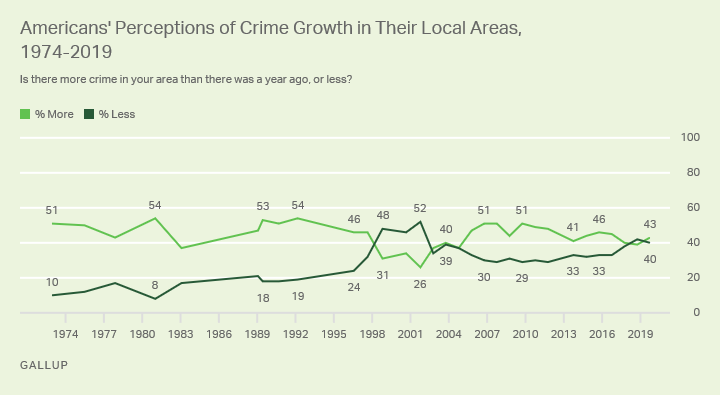Story Highlights
- Latest figure is up slightly from 48% in 2018
- Much smaller 13% describe crime in the area where they live as serious
- Most say U.S. crime is up, despite federal figures saying otherwise
WASHINGTON, D.C. -- A slim majority of Americans describe the problem of U.S. crime as "extremely" or "very serious." The latest 52% is up slightly from 48% in 2018 -- when this measure hit a low not seen since 2005 -- but remains down from 2015-2017, when figures of seriousness ranged between 59% and 60%.

These data are from Gallup's annual Crime poll, conducted Oct. 1-13 this year, which found that 48% describe the problem of U.S. crime as "moderately serious," "not too serious" or "not serious at all."
-
Americans remain much more likely to describe the problem of crime in the U.S. as extremely or very serious than to say this about crime in their local area (13%).
-
Women (58%) are more likely than men (46%) to describe U.S. crime as extremely or very serious. The gender gap shrinks when Americans are asked about crime in their local area, with 11% of men and 14% of women describing crime in their area as serious.
-
U.S. adults who say they live in urban areas (17%) are more likely to describe local crime as serious than are residents of suburban (8%) and rural areas (10%). These groups' perceptions vary slightly less on crime in the U.S. at large, ranging between 48% and 55%.
Most Say U.S. Crime Is Up, Despite Federal Statistics
Nearly two in three Americans say there is "more" crime in the U.S. compared with one year ago, while 24% say there is "less" crime and 9% say the level of crime has remained the same.
The percentage saying there is more crime is consistent with the historical average of 67% since 1989. In all but two polls over the past three decades, majorities of Americans have said there was more crime compared with the prior year.
Figures from the Bureau of Justice Statistics have shown a general decline in U.S. violent crime since the early 1990s. But aside from a decline in the percentage perceiving more U.S. crime from the early 1990s to the early 2000s, Americans' perceptions of crime across the country have usually differed from what the bureau has reported.

Mixed Perceptions of Crime Growth in Local Areas
Gallup has consistently found that Americans are more likely to say overall crime in the U.S. has grown than they are to say the same about crime in the area where they live. In all polls since 1989, the percentage of Americans perceiving greater crime in the U.S. has exceeded the percentage perceiving greater local crime by double digits.
Currently, 43% of Americans say there is more crime in their area than there was a year ago, while 40% say there is less crime.
Americans have been more evenly divided about their local crime trend in recent years than they had been in previous years. Since 2017, Americans have been about as likely to perceive that crime in their area has increased as to say it has decreased.
In most of Gallup's trend on this since 1974, Americans were more likely to say local crime had increased -- though a key exception was between 1998 and 2001, when about half said crime had decreased. This occurred at the tail end of steady declines in crime, as reported by the bureau.

Bottom Line
Perceptions of U.S. crime are frequently different from the reality of how much crime is actually occurring. This is not to say that Americans' perceptions are entirely removed from reality. U.S. crime indeed decreased after the early 1990s, and Americans responded by becoming less likely in the decade that followed to say the crime rate was going up. This was short-lived, however, as their perceptions of increased crime rebounded even as federal crime statistics continued to go down.
Regardless of how far from reality they are, perceptions of crime matter, as they can impact Americans' sense of safety and their confidence in law enforcement.
View complete question responses and trends.
Learn more about how the Gallup Poll Social Series works.




